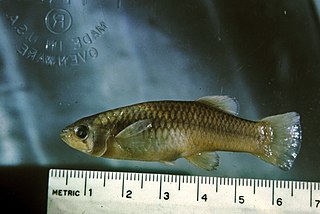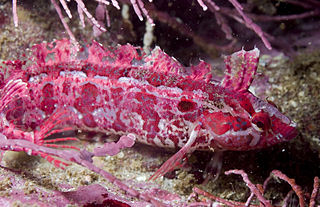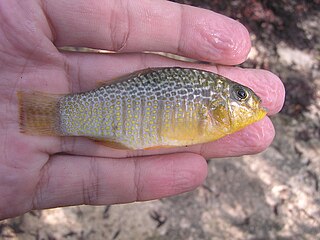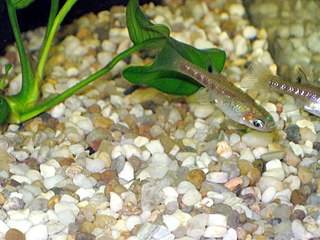The yellowfin gambusia is a species of fish in the family Poeciliidae. It is endemic to the Rio Conchos of Chihuahua, Mexico, where it is known as guayacon de san gregorio. This species was described in 1957 by Clark Hubbs and Victor G. Springer with the type locality given as El Ojo de San Gregorio in Chihuahua. The specific name of this fish honours the Mexican ichthyologist José Alvarez del Villar (1903-1986) for his work on the fishes of Mexico and for his assistance to Clark and Springer.

The Big Bend gambusia is a rare species of fish in the family Poeciliidae. It is endemic to the Big Bend region of the Rio Grande of the United States and Mexico. The only known remaining population is in a protected pond in the Big Bend National Park.
Gambusia hurtadoi, also known as crescent gambusia, is a species of fish in the family Poeciliidae. It is endemic to Chihuahua in Mexico, where it is known as guayacon de Hacienda Dolores. It grows to 3.5 cm (1.4 in) total length. The species was described in 1957 by Carl Leavitt Hubbs and Victor G. Springer with the type locality given as El Ojo de la Hacienda Dolores, 7 miles south of Jiminez, Chihuahua, the spring to which this species is endemic. Hubbs and Springer honoured the Mexican Leopoldo Hurtado Olin of the Departamento de Economía in Chihuahua for his assistance during their collecting expedition to Chihuahua in June 1951. Hurtado Olin also informed Hubbs and Springer of the location of El Ojo de la Hacienda Dolores.

Goodea is a genus of splitfins that are endemic to Mexico. They are found in a wide range of habitats in several river basins that originate in the Central Plateau, such as Pánuco, Lerma–Chapala–Grande de Santiago and Balsas. Overall this genus is among the most widespread and successful splitfins, although they also have declined and the relatively restricted G. gracilis is considered vulnerable by the IUCN. This genus includes the largests splitfins, reaching a standard length of up to 20 cm (8 in). They are primarily herbivores, but also take small organisms like tiny crustaceans and snails. The is named in honour of the American ichthyologist George Brown Goode (1851-1896).

The Highland splitfin is a species of splitfin endemic to Mexico where it is found in the Lerma River basin. This species grows to a length of 5 centimetres (2.0 in) TL. It is the only known member of its genus, although some authorities have Hubbina as a subgenus of Girardinichthys and add Girardinichthys ireneae to the subgenus, even treating this taxon as a synonym of G. ireneae. This species was described by Don Fernando de Buen y Lozano in 1940 with the type locality given as Cointzio, Michoacán. The name of the genus honours the American ichthyologist Carl Leavitt Hubbs (1894-1979) while the specific name honours Clarence Lester Turner (1890-1969), thus honouring two ichthyologists who worked on a review of the Goodeidae in 1939.

Goodeinae is a subfamily of splitfins from Mexico, part of the family Goodeidae. They are small fish which mostly live in fresh water, especially around Mesa Central, west of Mexico City. Members of the subfamily are also found in brackish water on both the east and west coasts. They typically have small ranges and many are seriously threatened. The subfamily takes its name from its type genus Goodea and so is ultimately named after the American ichthyologist George Brown Goode (1851-1896).
Neoclinus stephensae, the Yellowfin fringehead, is a species of chaenopsid blenny found in the eastern Pacific ocean. It can reach a maximum length of 10 centimetres (3.9 in) TL. The specific name honours the collector of the type, the British-American conchologist Kate Stephens who was Curator of Mollusks and Marine Invertebrates at San Diego Natural History Museum and who was over 100 years old at the time the species was described.

Gibbonsia is a genus of clinids native to the eastern Pacific ocean. The name of this genus honours the American naturalist, physician and founder member of the California Academy of Sciences, William P. Gibbons (1812-1897).
Malacoctenus hubbsi, the redside blenny, is a species of labrisomid blenny native to the Gulf of California extending to the Pacific coast of southern Baja California. It is found in rocky areas at depths of from 1 to 4 metres. This species can reach a length of 9 centimetres (3.5 in) TL. The specific name honours the American ichthyologist Clark Hubbs (1921-2008).
Paraclinus walkeri, the San Quintin blenny, is a species of labrisomid blenny native to the coasts of Baja California Sur, Mexico. The specific name honours the fisheries biologist Boyd W. Walker (1917-2001) of the University of California, Los Angeles who placed his specimens at the disposal of Clark Hubbs.
Lepidonectes clarkhubbsi, known commonly as the signal triplefin, is a species of triplefin blenny in the genus Lepidonectes. It was described by William Albert Bussing in 1991 and he gave it a specific name which honours the American ichthyologist Clark Hubbs (1921–2008). This species occurs in the eastern Pacific Ocean where it is found off Costa Rica and Panama. The signal triplefin is found on rocky shores where it feeds on very small invertebrates and algae.
Scomberesox is a genus of sauries. It is one of two in the family Scomberesocidae. The generic name Scomberesox is a he name id a compound of scomber, which in turn is derived from the Grek skombros, meaning "mackerel", and the Latin esox meaning pike.

Floridichthys is a genus of pupfishes native to the southeastern United States, Mexico and northern Central America. The name of this genus is a compound of Florida and the Greek for "fish", ichthys. The ichthyologist Carl Leavitt Hubbs thought that the genus was confined to Florida at the time he coined the name.
The Yucatan flagfish, also known as the snakeskin killifish, is a species of pupfish from the family Cyprinodontidae. It is found in the coastal waters of the Yucatan Peninsula, in Mexico and Belize. This species grows to a length of 4 centimetres (1.6 in) TL and is found in the aquarium trade. This species was described by Carl Leavitt Hubbs in 1936 with the type locality given as 5 kilometres (3.1 mi) east of Progreso, Yucatán, Mexico. It is the only known member of its genus. The name of the genus commemorates the American ichthyologist Samuel Garman (1843-1927) who was working on a revision of his 1895 monograph on the Cyprinodontidae at the time of his death. It is sometimes treated as a junior synonym of Jordanella.

Girardinus is a genus of poeciliids native to Cuba. The name of this genus honours the French zoologist Charles Frédéric Girard (1822-1895) for his work on the freshwater fish of North America.
The Mexican rivulus is a species of killifish from the family Rivulidae which is endemic to Mexico where it is found in the Papaloapan and Coatzacoalcos River basins. This annual killifish grows to a total length of 4 cm (1.6 in). It is the only known species in its genus, but its exact taxonomic position remains uncertain, as it has not been included in any phylogenetic study. This species was described by Robert Rush Miller and Carl Leavitt Hubbs as Rivulus robustus in 1974, it was reclassified in the monotypic genus Millerichthys in 1995, the generic name honouring Robert Rush Miller.

Selar is a genus of ray-finned fishes from the family Carangidae which includes the scads, jacks, pompanos, trevallies and horse mackerels. The generic name, Selar, is the local name for the oxeye scad in Jakarta.

Tlaloc is a genus of fish in the family Profundulidae endemic to Mexico, Guatemala and Honduras. The genus is not, however, recognised by Fishbase or in the 5th Edition of Fishes of the World. The genus is named for Tlaloc the water god of the Aztecs.
Brockius is a genus of labrisomid from the waters of the eastern Pacific and the western Atlantic where they are associated with reefs and weed covered rocks.
McCulloch's hardyhead is a species of silverside from the family Atherionidae. This species occurs off the coasts of Australia. It was described by David Starr Jordan and Carl Leavitt Hubbs in 1919 from a type locality of Lord Howe Island and the specific name honours the Australian ichthyologist Allan Riverstone McCulloch (1885-1925), who was Curator of Fishes at the Australian Museum and who provided Jordan and Hubbs with the type.








